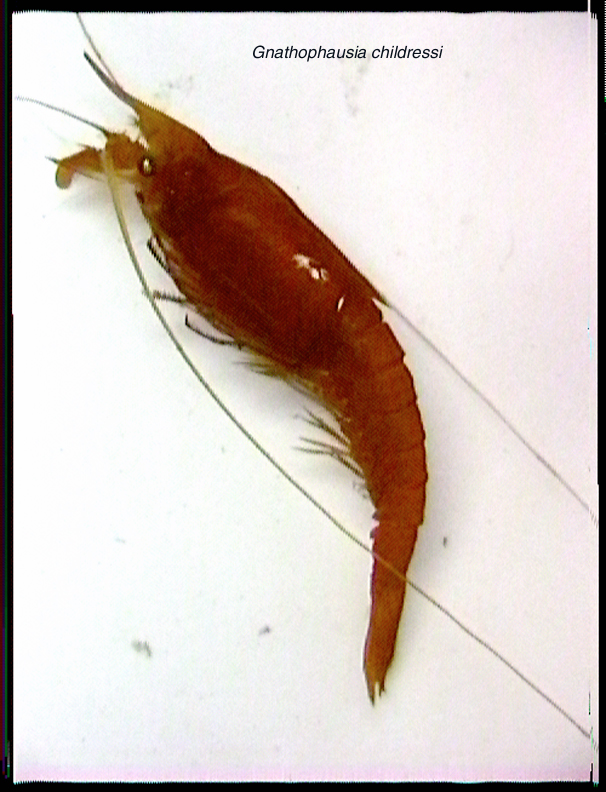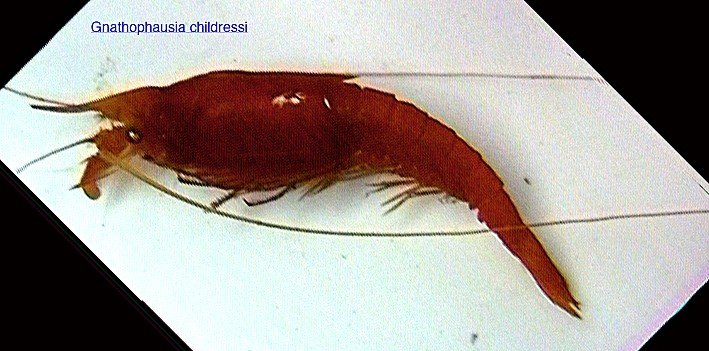Gnathophausia childressi Casanova, 1996Common name(s): Childress' benthopelagic opossum shrimp |
|
| Synonyms: |  |
| Phylum Arthropoda
Subphylum Crustacea Class Malacostraca Subclass Eumalacostraca Superorder Peracarida Order Lophogastrida Family Lophogastridae (or Gnathophausiidae) |
|
| Gnathophausia childressi (captured at 1900 m depth, San Clemente Basin?) | |
| (Photo by: Jim Childress) | |
How to Distinguish from Similar Species: This species is very similar to Gnathophausia affinis, which is also rare and found only in the Atlantic Ocean. It differs from G. affinis by having: Only one lateral keel on the carapace instead of two; a longer carapace which completely covers the last thoracic segment, and the dorsal groove on the telson is narrow anteriorly. Of the local species, it differs from G. gracilis by having no dorsal keel on the abdominal segments, from N. ingens and N. gigas by having no posteroventral spine on the carapace, and from G. zoea and G. longispina because the lateral keel on the carapace does not curve dorsally as it approaches the posterior margin of the carapace.
Geographical Range: Collected from the San Clemente Basin and East Cortez Basin, CA. Not seen in the Santa Catalina basin.
Depth Range: 1708-1940 m
Habitat: Bathypelagic, living in the benthic boundary layer (within a few tens of meters of the bottom). Captured within 0.3m of bottom.
Biology/Natural History: This species seems to stay in the benthic boundary layer of the bathypelagic zone, where particulate abundance is higher than that in the main water column. The fact that they are benthopelagic may explain why they have been so rarely caught--they are too near the bottom to be caught with a midwater trawl, yet do not rest on the bottom so are rarely caught with benthic trawls. According to Childress, they can be relatively common in the regions where they occur, but just off the bottom. The mandibles of this species are smaller and less chitinized than those of most other Gnathophausia. This has been interpreted to indicate that this species feeds at least partly on the flocculent material in the water instead of by predation.
| Return to: | |||
| Main Page | Alphabetic Index | Systematic Index | Glossary |
References:
Dichotomous Keys:General References:
Scientific Articles:
Casanova, Jean-Paul, 1996. Gnathophausia childressi,
new
species, a mysid from deep near-bottom waters off California, with
remarks
on the mouthparts of the genus Gnathophausia.
Journal of Crustacean
Biology 16:1 192-200
Childress, J.J., D.L. Gluck, R.S. Carney, and M.M. Gowing, 1989. Benthopelagic biomass distribution and oxygen consumption in a deep-sea benthic boundary layer dominated by gelatinous organisms. Limnology and Oceanography 34: 913-930
Web sites:
General Notes and Observations: Locations, abundances, unusual behaviors:

Another photo of this species by Jim Childress. These photos
are some of the only ones extant of this species shortly after capture.
Authors and Editors of Page:
Dave Cowles (2006): Created original page